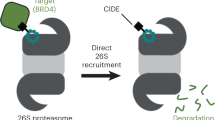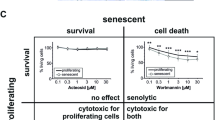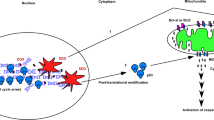Abstract
We have examined the effects of inhibition of the 26S proteasome in a murine mammary cell line, KIM-2 cells using the peptide aldehyde inhibitor MG132. These studies have demonstrated a clear requirement for proteasome function in cell viability. Induction of apoptosis was observed following MG132 treatment in KIM-2 cells and this death was shown to be dependent on the cell actively traversing the cell cycle. KIM-2 cells were generated using a temperature sensitive T-antigen (Tag) and studies at the permissive temperature (33°C) have shown that a Tag binding protein was essential for this apoptotic response. Studies in two additional cell lines, HC11, which is a mammary epithelial cell line carrying mutant p53 alleles and p53 null ES cells suggest that p53 is actively required for the apoptosis induced as a consequence of proteasome inhibition. These results suggest a pivotal role for the 26S proteasome degradation pathway in progression through the cell cycle in proliferating cells. Cell Death and Differentiation (2001) 8, 210–218
Similar content being viewed by others
Log in or create a free account to read this content
Gain free access to this article, as well as selected content from this journal and more on nature.com
or
Abbreviations
- ALLM:
-
Ac-Leucinyl-leucinyl-methional
- E64:
-
trans-epoxysuccinyl-L-leucylamido-3-methyl-butane ethyl ester
- GF:
-
growth factor
- MG132:
-
Cb2-leucinyl-leucinyl-leucinal
- PMSF:
-
phenylmethylsulphonyl fluoride
References
Hilt W, Wolf DH . 1996 Proteasomes: destruction as a programme Trends Biochem. Sci. 21: 96–102
Deveraux Q, Ustrell V, Pickart C, Hochstrasser M . 1994 A 26S protease subunit that binds ubiquitin conjugates J. Biol. Chem. 269: 7059–7061
Chen Z, Hagler J, Palombella VJ, Melandri F, Scherer D, Ballard D, Maniatis T . 1995 Signal induced site specific phosphorylation target of IκBα to the ubiquitin-proteasome pathway Genes Dev. 9: 1586–1597
Glotzer M, Murray AW, Kirschner MW . 1991 Cyclin is degraded by the ubiquitin pathway Nature 349: 132–138
Wyllie AH, Kerr JFR, Currie AR . 1980 Cell death: the significance of apoptosis Int. Rev. Cytol. 68: 251–306
Yuan J-Y, Shaham S, Ledoux S, Ellis HM, Horvitz HR . 1993 The C. elegans death gene ced-3 encodes a protein similar to mammalian interleukin-1β-converting enzyme Cell 75: 641–652
Gordon KE, Binas B, Chapman RS, Kurian KM, Clarkson RWE, Clark AJ, Lane EB, Watson CJ . 2000 A novel cell culture model for studying differentiation and apoptosis in the mouse mammary gland Breast Cancer Res. 2: 222–235
Rock KL, Gramm C, Rothstein L, Clark K, Stein R, Dick L, Hwang D, Golberg AL . 1994 Inhibitors of the proteasome block the degradation of most cell proteins and the generation of peptides presented on MHC Class I molecules Cell 78: 761–771
Grimm LM, Goldberg AL, Poirier GG, Schwartz LM, Osborne BA . 1996 Proteasomes play an essential role in thymocyte apoptosis EMBO J. 15: 3835–3544
Sadoul R, Fernandez P-A, Quiquerez A-L, Martinou I, Maki M, Schroter M, Becherer JD, Irmler M, Tschopp J, Martinou J-C . 1996 Involvement of the proteasome in the programmed cell death of NGF-deprived sympathetic neurons EMBO J. 15: 3845–3852
Drexler HCA . 1997 Activation of the cell death program by inhibition of proteasome function Proc. Nat. Acad. Sci. USA 94: 855–860
Schreier A, Gruber J . 1990 Viral T-antigen interactions with cellular proto-oncogenes and anti-oncogene products J. Natl. Cancer Inst. 582: 354–360
Evan GI, Brown L, Whyte M, Harrington E . 1995 Apoptosis and the cell cycle Curr. Opin. Cell Biol. 7: 825–834
Scheffner M, Werness BA, Huibregtse JM, Levine AJ, Howley PM . 1990 The E6 oncoprotein encoded by human papillomaviruses types 16 and 18 promotes the degradation of p53 Cell 63: 1129–1136
Chang Y-C, Lee Y-S, Tejima T, Tanaka K, Omura S, Heintz NH, Mitsui Y, Magae J . 1998 mdm2 and bax, Downstream mediators of the p53 Response, Are degraded by the Ubiquitin-Proteasome Pathway Cell Growth Differ. 9: 79–84
Merlo GR, Basolo F, Fiore L, Duboc L, Haynes NE . 1995 p53-dependent and p53-independent activation of apoptosis in mammary epithelial cells reveals a survival function for EGF and insulin J. Cell Biol. 128: 1185–1196
Corbet SW, Clark AR, Gledhill S, Wyllie AH . 1999 p53-dependent and independent links between DNA damage, apoptosis and mutation frequency in ES cells Oncogene 18: 1537–1544
Nurse P . 1994 Ordering S-phase and M-phase in the cell cycle Cell 79: 547–550
Lopes UG, Erhardt P, Yao R, Cooper GM . 1997 p53-dependent induction of apoptosis by proteasome inhibitors J. Biol. Chem. 272: 12893–12896
Wojcik C, Schroeter D, Stoehr M, Wilk S, Paweletz N . 1996 An inhibitor of the chymotrypsin-like activity of the multicatalytic proteinase complex (20S proteasome) induces arrest in G2-phase and metaphase in HeLa cells Eur. J. Cell Biol. 70: 172–178
Kulka RG, Raboy B, Schuster R, Parag HA, Diamond G, Ciechanover A, Marcus M . 1998 A chinese hamster cell cycle mutant arrested at G2 phase has a temperature-sensitive ubiquitin-activating enzyme J. Biol. Chem. 263: 15726–15731
Finley D, Sadis S, Monia BP, Bouchet P, Ecker DJ, Crooke ST, Chau V . 1994 Inhibition of proteolysis and cell cycle progression in a multiubiquitination-deficient yeast mutant Mol. Cell Biol. 14: 5501–5509
Guillouf C, Krishnaraju K, Moustachhi E, Hoffman B, Liebermann DA . 1995 p53 involvement in control of G2 exit of the cell cycle: role in DNA damage-induced apoptosis Oncogene 10: 2263–2270
Hoffman F, Martelli F, Livingston DM, Wang Z . 1996 The retinoblastoma gene product protect E2F-1 from degradation by the ubiquitin proteasome pathway Genes Dev. 10: 2949–2959
Johnson DG, Schwarz JK, Cress WD, Nevins JR . 1993 Expression of transcription factor E2F1 induces quiescent cells to enter S-phase Nature 365: 349–352
Author information
Authors and Affiliations
Corresponding author
Additional information
Edited by BA Osborne
Rights and permissions
About this article
Cite this article
MacLaren, A., Chapman, R., Wyllie, A. et al. p53-dependent apoptosis induced by proteasome inhibition in mammary epithelial cells. Cell Death Differ 8, 210–218 (2001). https://doi.org/10.1038/sj.cdd.4400801
Received:
Revised:
Accepted:
Published:
Issue date:
DOI: https://doi.org/10.1038/sj.cdd.4400801
Keywords
This article is cited by
-
Molecular analysis of cell survival and death pathways in the proteasome inhibitor bortezomib-resistant PC3 prostate cancer cell line
Medical Oncology (2021)
-
The essential role of TAp73 in bortezomib-induced apoptosis in p53-deficient colorectal cancer cells
Scientific Reports (2017)
-
Detrimental effects of proteasome inhibition activity in Drosophila melanogaster: implication of ER stress, autophagy, and apoptosis
Cell Biology and Toxicology (2013)
-
The p53-independent induction of apoptosis in breast cancer cells in response to proteasome inhibitor bortezomib
Tumor Biology (2012)
-
Disruption of a mitochondrial protease machinery in Plasmodium falciparum is an intrinsic signal for parasite cell death
Cell Death & Disease (2011)



